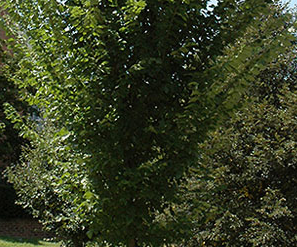The Princeton elm, also known as Ulmus americana ‘Princeton,’ is often regarded as the noblest of all trees used for providing shade. This decorative tree features an overhead arch and a majestic vase shape. The adaptability and resilience of these elms are exceptional. The Princeton Elm is a variety of American Elm that is chosen for its robust growth and erect, symmetrical habit. The Princeton elm is a fantastic addition to street tree plantings or areas with low soil because of its tolerance of urban environments and great resistance to Dutch elm disease.
The ‘Princeton’ cultivar is an older variety with a quick growth rate. It was raised in 1922 and positioned along Washington Avenue near Princeton University’s main entrance in New Jersey. These approximately 60-foot-tall trees are subjected to a variety of pressures during their development. It’s a traditional American elm and resists Dutch elm disease.
The majority of American streets used to be lined with elm trees. The Dutch elm disease, which arrived in the 1930s, was responsible for the death of thousands of trees. Elms were not considered a great choice for landscapes for many years. The Princeton elm, on the other hand, has proven to be a hardy variety. This tree is mostly found to be resistant to a variety of illnesses and insects.
Princeton Elm Tree Pros and Cons
The Princeton Elm is a wonderful selection for use as a shade tree, street tree, or accent tree in the garden. The Princeton elm particularly shines in its role as a street tree. It is useful to place them beside streets or sidewalks as they are more resistant to damage than other types of elms. It flourishes best in full sun but requires only around six to eight hours of direct sunlight every day to thrive in partial shade. These trees not only make the yard more attractive, but they also provide people with a significant amount of shade throughout the hot summer months.
Many migrant bird species live in the crotches of Princeton Elm branches. The Princeton Elm is a valuable source of nutrition for birds and rodents once its seeds begin to mature.
It is not recommended to utilize any elms, even Princeton Elm, to replace trees that are killed by Verticillium Wilt because they are not susceptible to the fungus. Most varieties of American Elm and others related to it are self-sterile. Individual trees can yield fruit, but these fruits are hardly sustainable. If fruit production is desired, plant American Elm cultivars such as Princeton Elm separately to prevent cross-pollination.
Princeton Elm Tree Growth Rate
This Princeton elm is also commonly known as the American elm. It reaches a height of between 60 and 80 feet and is classified as a medium to a large deciduous tree. The crown of this tree is vase-shaped and broad-rounded. Small green blooms start to bloom on the branches in the spring before the leaves begin to appear. The leaves attain their full size between April and May. The leaves of the Princeton elm are six inches in length and possess a rough texture. The elm’s leaves turn yellow in the autumn.
Princeton Elm Tree Care
This American Elm is ideally suited for cold regions and is tolerant of harsh conditions like compacted soil, drought, air pollution, and poor drainage. It grows best in full sun and well-drained, nutrient-rich soil, and does not perform well in sand, drought, or wet soil. American elms require constant checking for any symptoms of illness.
Elm saplings are also a favored diet of deer, therefore keep young elm trees protected or use a repellent. It’s important to keep elms healthy. Elms are quite simple to transplant and become established in their new locations; for the best results, put them in nutrient-dense soil with a pH of 6 or 7 and full light, and continue to water them deeply regularly until they are well established.
Princeton Elm Tree Problems
This American elm is significantly more upright than most American elm seedlings, and it is this tendency that necessitates careful pruning in its formative years, as its side branches develop rapidly and easily become defective.
Elms are susceptible to damage from a variety of parasites and insects in addition to Dutch elm disease, including bark beetles, gypsy moths, mites, scales, and elm borer. It is possible for leaf beetles to consume enormous amounts of foliage, but they do not necessarily harm the tree itself.



